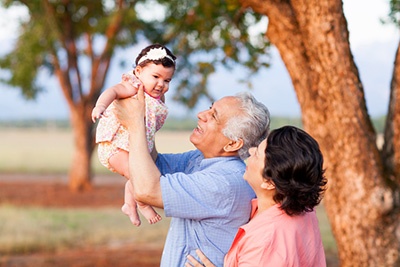
From safe sleep to car seats, infant care recommendations have changed a lot. Here’s how to get grandparents and other caregivers on board.
As child safety recommendations evolve, it can be challenging for parents, let alone grandparents, to stay current.
“When today’s grandparents were parenting their own children, they were working with the best information they had at that time,” says Lorena Kaplan, campaign lead for the Safe to Sleep initiative of the Eunice Kennedy Shriver National Institute of Child Health and Human Development.
When talking to grandparents and other caregivers, parents can frame the conversation around cooperation rather than correction. Doing what’s best for baby means following the latest safety recommendations.
“Injury prevention is a science-based discipline,” says Dorothy A. Drago, the author of “From Crib to Kindergarten: The Essential Child Safety Guide.” “We don’t want to scare people, but we do want them to understand that we know more now, and we can do more in the field of prevention.”
So what do you say when Grandma wants to put a fluffy blanket in the baby’s crib or Grandpa wants to take the toddler for a quick ride without a car seat? Here’s the latest expert advice to keep little ones safe during sleep and on the go.
A Safe Place to Sleep
Putting babies to sleep on their backs emerged as a strategy to prevent sudden infant death syndrome (SIDS) during the early 1990s, leading to a dramatic reduction in cases of SIDS—4,073 babies died from SIDS in 1994, compared with 2,643 in 1999.
What began as the Back to Sleep campaign changed its name in 2012 to Safe to Sleep. It addresses many factors of a baby’s sleep environment, Kaplan says. To reduce the risk of all sleep-related infant deaths, including accidental suffocation or strangulation in bed, experts recommend the following guidelines for all parents and caregivers:
- Always put babies up to a year old to sleep on their backs. Once they are old enough to roll over in their sleep, you don’t have to turn them back over.
- Use a crib or bassinet that meets current safety standards, with only a fitted sheet—no blankets, pillows, bumper pads or stuffed animals. A sleeper or wearable blanket is enough to keep the baby warm.
- Keep babies in the same room—but not in the same bed—as their parents, “where the baby can be more closely monitored,” Kaplan says. Room sharing may decrease the risk of SIDS by as much as 50 percent, according to the American Academy of Pediatrics.
Consistency in safe sleep practices is important, since unaccustomed tummy sleeping carries a high risk for SIDS. Babies who are placed to sleep on their tummies when they are used to sleeping on their backs are 18 times more likely to die from SIDS.
Ready for the Road
From rear-facing seats to long-term use of boosters, current car seat recommendations may seem extreme to grandparents used to the free and easy days of jumping in the car with kids.
But with more and bigger cars on the road driving at higher speeds, “it’s a different world now,” says Drago. “The physics of a crash tell you that the bigger the car and the faster it’s going, the more severe the injuries you can have.”
The American Academy of Pediatrics recommends the following for car seat safety:
- Babies and toddlers should be in a rear-facing car seat until they are at least 2 years old or until they reach the highest weight or height allowed by their car seat’s manufacturer.
- Toddlers and preschoolers should use a front-facing car seat with a harness as long as possible for their weight and height.
- Once they outgrow their car seat, kids should be in a belt-positioning booster seat until the vehicle’s seat belt fits correctly—typically at a height of 4 feet 9 inches and between 8 and 12 years old.
- Kids younger than 13 should be in the back seat.
If you’re looking for a physician who’s aligned with your health needs and goals, find a Beaufort Memorial OB-GYN or pediatrician anytime in our online directory.
